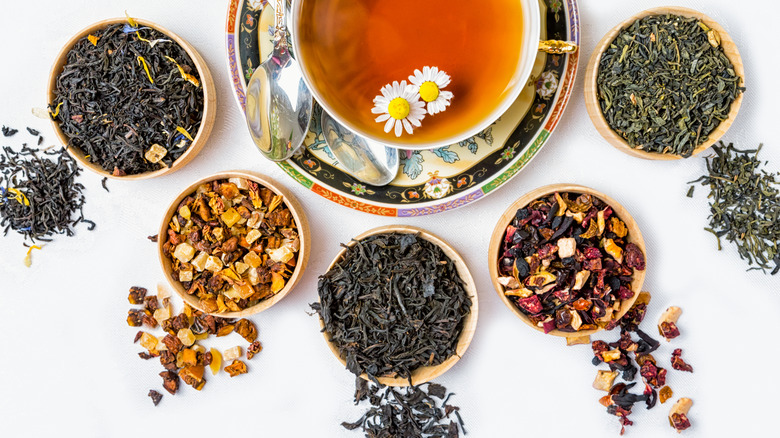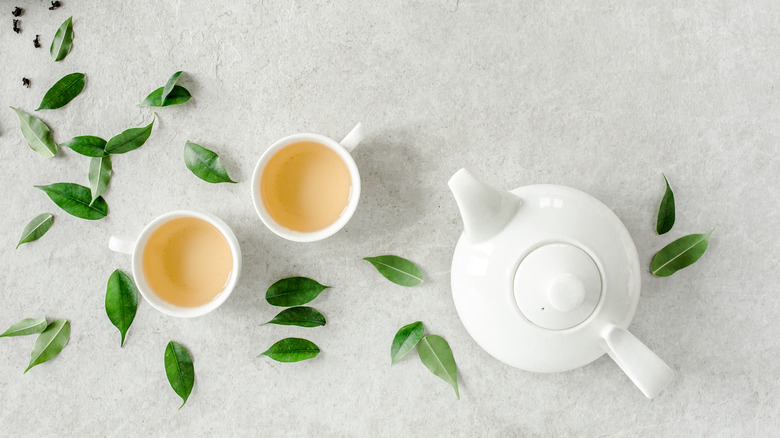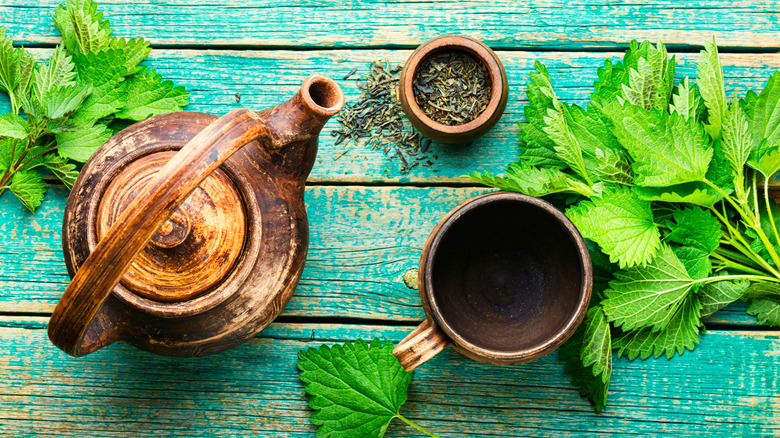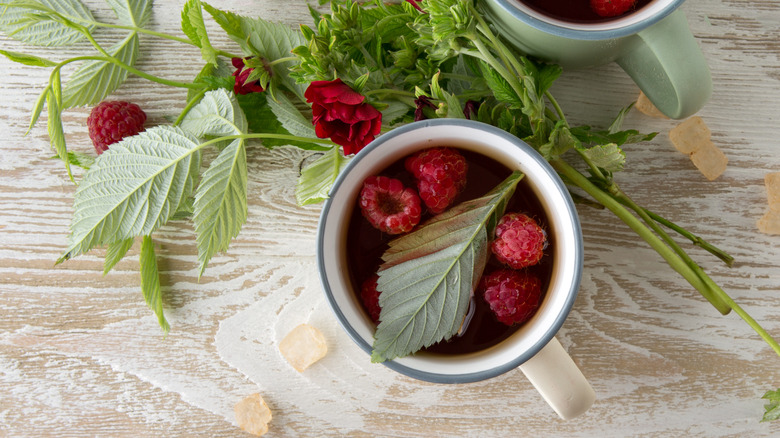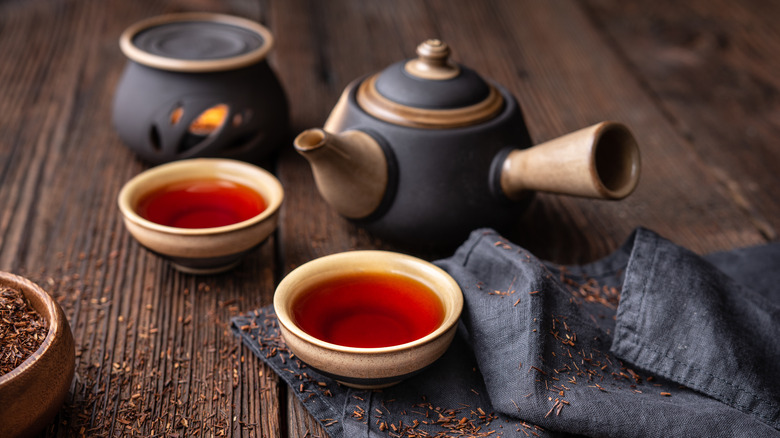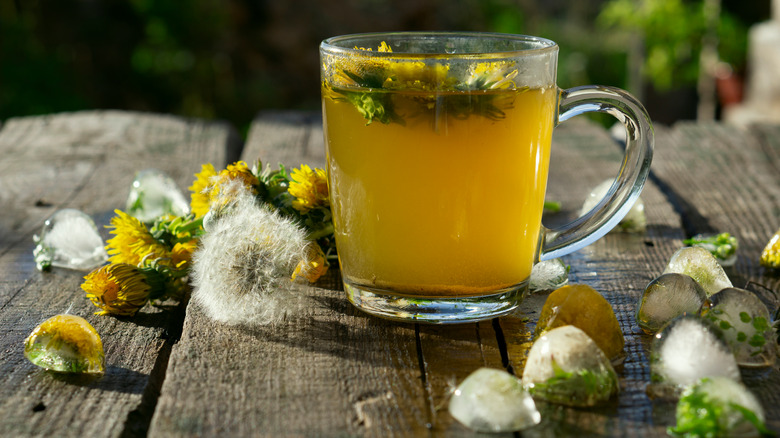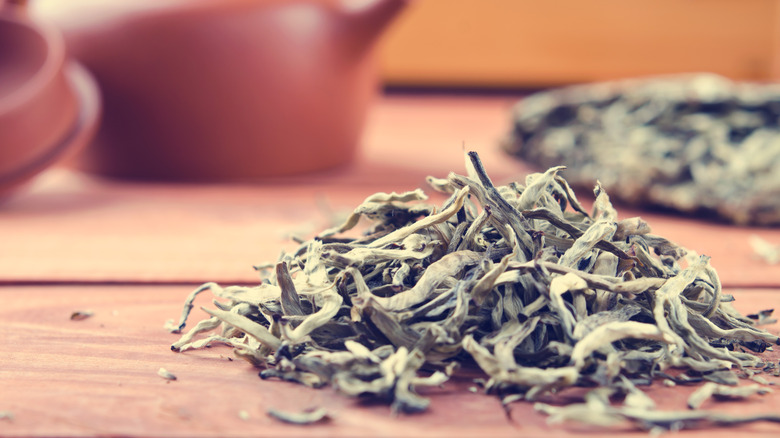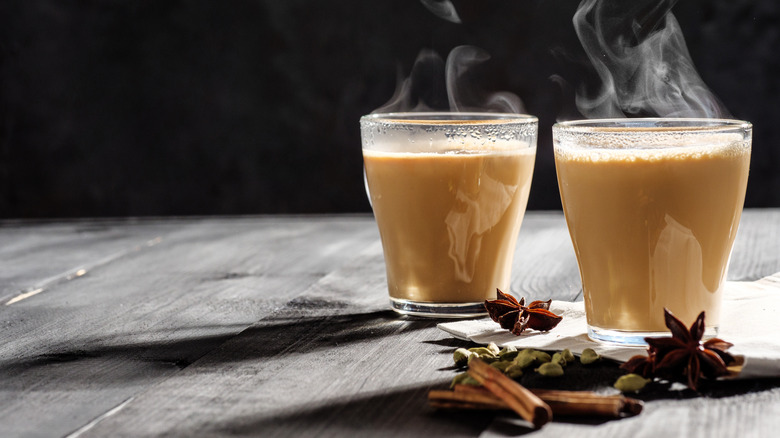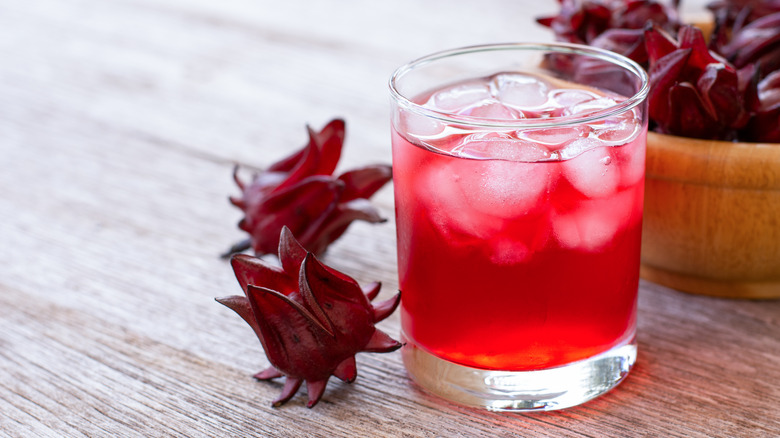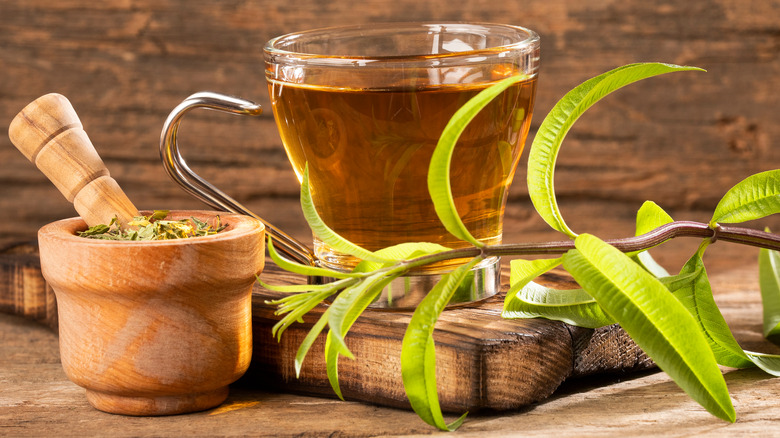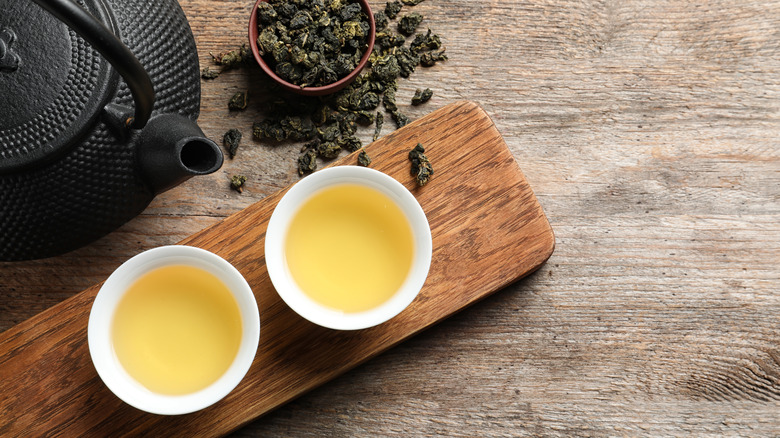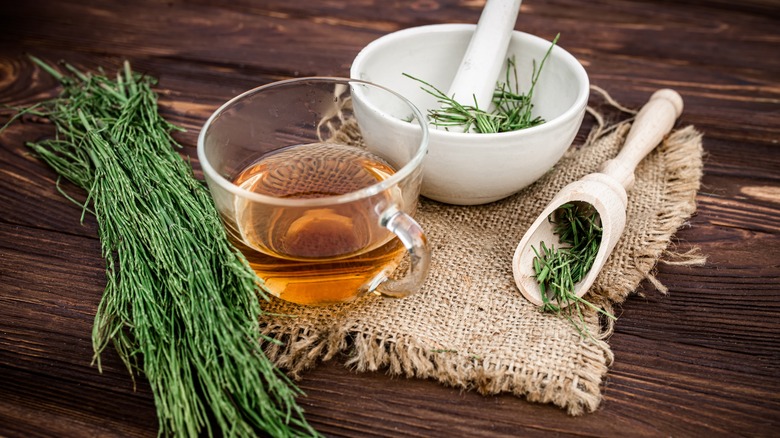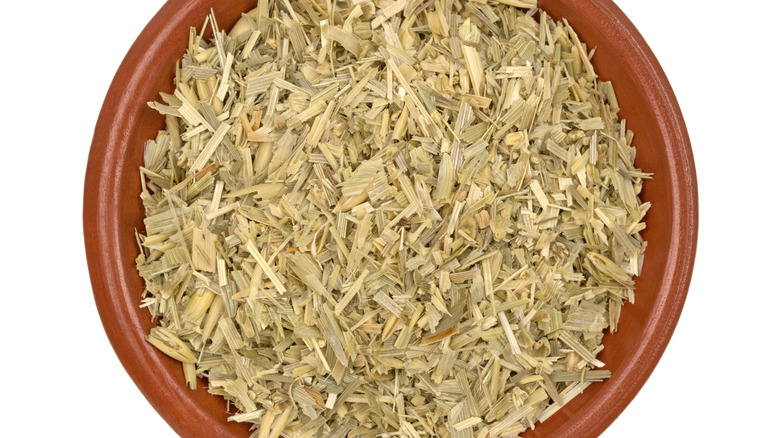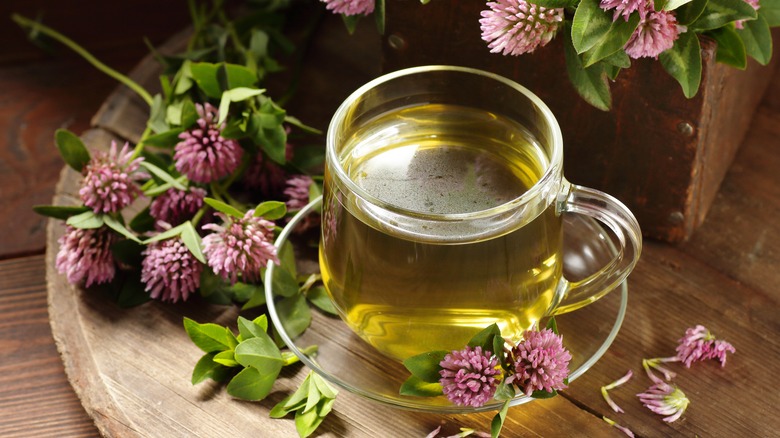13 Teas You Should Drink For Your Health
We may receive a commission on purchases made from links.
An ancestral drink that, according to legend, has been around since 2700 BCE, tea is only surpassed by water when it comes to worldwide consumption. Based on Statistica data, more than 6 billion kilograms of tea was consumed in 2020 alone. Good news for tea lovers everywhere, Amanda Sevilla, registered dietician nutritionist, shared with Eat This, Not That! that a daily cup goes hand-in-hand with longevity. And, according to a 2015 study published in Critical Reviews in Food Science and Nutrition, tea can be anti-inflammatory and anti-carcinogenic, can lower cholesterol, and might ward off cardiovascular disease, diabetes, and arthritis.
But while drinking tea is generally considered healthy, you can boost its benefits further by selecting varieties known for their antioxidants and medicinal properties. If you're only familiar with black and green tea, you might be missing out on more obscure types such as nettle tea and white peony tea. Dive into the fascinating world of tea, where the simple act of steeping dried leaves in hot water may just give you glowing skin, improved concentration, and enhanced immunity, all while being a source of flavor and comfort. Sit comfortably with a steaming cup of one of the following varieties, and discover your next favorite blend.
Green tea
Green tea has a reputation for being high in health-promoting compounds, and with good reason. According to Healthline, green tea isn't just hydrating, it's also rich in polyphenols and natural antioxidants, can boost brain function thanks to its gentle amounts of caffeine and L-theanine, may increase fat burning, and prevent heart disease and diabetes. Pretty impressive!
Matcha is a kind of green tea processed differently, in that the leaves are shade-grown before being ground. WebMD goes on to explain that this creates a tea higher in caffeine and theanine. Also, just like green tea, matcha can provide cardiovascular benefits, including a lower risk of atherosclerosis, hypertension, and congestive heart failure.
If you've tried green tea before and found it unpalatable, it may have been improperly prepared. The Kitchn advises brewing it at a maximum of 160-180 F in a pre-heated teapot with about 1 teaspoon tea leaves for every 6 ounces water. You should also only brew for 1-3 minutes, checking every 30 seconds to taste for the perfect balance of flavor.
Nettle tea
If you've ever been stung by stinging nettles in the forest, you might not be too keen on consuming the spiky weed. But that would be a mistake, as Medical News Today shares that nettle leaves are high in vitamins C, D, and K, as well as iron, selenium, zinc, magnesium, and antioxidants. A 2018 study published in the peer-reviewed journal Molecules reported that every part of the nettle plant has antioxidant and antimicrobial properties, and can be consumed in juice, tea, and as an ingredient in many dishes. Celebrity chef Jamie Oliver shared a recipe for stinging nettle ravioli on his website, calling the prickly plant a good source of vitamin C, and "nothing to be afraid of."
While most studies have been done using whole, fresh nettle leaves, it's believed there are benefits to consuming the steeped, dried leaves as well. According to herbalist Susun Weed, drying the leaves and steeping them for at least 4 hours is the best way to extract the nutrients. For nettles and other herbs, she recommends steeping 1 ounce of the dried herb in a quart jar filled with boiling water for at least four hours, or overnight.
Raspberry leaf tea
A favorite of women during pregnancy, red raspberry leaf tea tastes similar to black tea, but is completely caffeine free. You can brew it like tea, by steeping a tea bag in boiled water, or you can make an infusion by steeping a cup of dried raspberry leaves in a quart jar filled with boiling water for 4-6 hours. According to Nicole Galan, author of the Everything Fertility book, raspberry leaf tea is a uterine tonic which can promote contractions during childbirth. For this reason, Certified Integrative Health and Nutrition Coach Liberty Mills recommends that pregnant women avoid drinking it during the first trimester, and instead, start drinking it after 32 weeks of pregnancy (via Net Doctor).
Net Doctor also reports that raspberry leaf tea is filled with vitamins B, C, and E, as well as the minerals manganese and magnesium, and is an antioxidant with anti-inflammatory properties. It's also a great source of iron with 18 percent of the recommended daily intake in 28 grams (about one ounce) of the leaves.
If you want to add the benefits of raspberry leaf tea to your diet, one easy way to do so is to substitute sub it in for black tea in the afternoon or evening hours. For instance, if you tend to drink a cup of caffeinated tea or coffee in the afternoon or evening, you could switch to raspberry leaf tea to reduce your caffeine intake and facilitate sleep.
Rooibos tea
A dark red brew made from the dried leaves of the rooibos bush from the Western Cape province of South Africa, rooibos is the only known source of the aspalathin flavonoid. According to a 2019 study published in PLoS One, this is an antioxidant which might help reverse hepatic insulin resistance due to its beneficial effects on metabolism and mitochondrial respiration. The benefits of rooibos tea are plentiful. For instance, rooibos tea is thought to have antioxidant and anti-inflammatory properties, could improve heart health, may reduce blood pressure, reduce cancer risk, lower blood sugar, aid in weight loss, and reduces wrinkles (via Medicine Net). While many rooibos studies have been conducted on animals rather than humans, the results are encouraging.
To prepare the perfect cup of rooibos tea, SF Gate recommends using 1 ½ teaspoons tea leaves for every 8 ounces boiling water, steeping them for at least 5-6 minutes. You can also steep the leaves for longer, as was done in a 2014 study published in the peer-reviewed journal PLos One. The researchers steeped the leaves in room temperature water for 30 minutes before filtering out the leaves and dispensing the tea into water bottles for drinking.
Dandelion tea
Dandelions aren't only a weed growing in backyards, they're also a medicinal plant with notable health benefits. According to a 2009 clinical trial published in the Journal of Alternative and Complementary Medicine, dandelion is an effective diuretic that can help reduce water weight. A 2017 study published in Molecules found that dandelion root extract might benefit liver function; a 2008 study published in Nutrition Research and Practice found it may help break down fat to facilitate weight loss, and a 2011 study published in Evidence-Based Complementary and Alternative Medicine found that dandelion root extract might even help kill melanoma cancer cells.
And that's only the tip of the iceberg when it comes to the benefits of dandelion. If you wish to add some of its medicinal goodness to your daily routine, nothing could be easier. To make the perfect cup of dandelion root tea, Sensha Tea Bar recommends adding dried and roasted ground roots, or at least small dried root pieces, to boiling water, simmering for 20 minutes. Then, simply strain and serve.
For dandelion flower tea, Tea Swan recommends steeping 10 dandelion flowers without the leaves attached in 1 cup of boiling water for 20 minutes. Or, you can always simply pick up dandelion tea bags at the store.
White tea
White tea, which can be hard to find due to its price and rarity, is a treat that might very well become part of your daily self-care routine. It comes from the same plant as the one used for black and green tea, but is different because it's harvested young, is minimally processed, and isn't rolled or oxidized like other types of tea (via Dr. Axe).
Some of the potential benefits noted in scientific studies on white tea include kickstarting fat-burning efforts (via Nutrition and Metabolism), killing some types of lung cancer cells (via Cancer Prevention Research), and preserving sperm quality in pre-diabetic patients (via Journal of Nutritional Biochemistry).
The world of white tea is diverse, with varieties like white peony, which is made using young tea leaves and tea buds that unfurl while steeping, or silver needle, which is made solely from young tea buds, as explained by Sensa Tea Bar.
For the perfect cup, The Kitchn recommends using 6 ounces of water for 2 teaspoons of buds or 2 tablespoons of light and fluffy leaves. The water should be heated to 170 F, or just shy of boiling. Then, steep the tea for 1-5 minutes, tasting regularly for your perfect balance of flavor.
Masala chai tea
Chai means "tea" in many countries, with masala chai being the sweet, spiced brew commonly refer to as "chai tea." Healthline explains that masala chai is brewed using a mix of water and milk, black tea, and a combination of spices including ginger, cardamom, cinnamon, fennel, black pepper, cloves, star anise, coriander seeds, and peppercorns.
The benefits of these ingredients are well documented. For instance, a 2015 study published in Clinical Nutrition found that black tea can help reduce levels of LDL cholesterol, commonly known as "bad cholesterol." There's evidence that cinnamon can do the same (via Diabetes Care). And a 2015 study published in the Iranian Journal of Pharmaceutical Research suggests that ginger is beneficial for people with type II diabetes.
The problem with commercial masala chai is it's often loaded with sugar. A grande chai latte from Starbucks has 240 calories and 42 grams of sugar. The American Heart Association recommends a maximum of 100 calories of added sugar per day for women, and 150 for men. The Harvard T.H. Chan School of Public Health notes that works out to 24 or 36 grams of added sugar per day, for women and men, respectively, putting the Starbucks' brew above the limit.
To make your own chai with fewer added sugars, The Minimalist Baker recommends making a mix from cinnamon sticks, green cardamom pods, black peppercorns, cloves, water, grated ginger, loose leaf black tea, dairy-free milk, and sweeteners such as stevia or maple syrup, to taste.
Hibiscus tea
A plant ubiquitous in many gardens, hibiscus is more than just an eye-catching addition to the landscape. It can also be used to make a deep red, tangy, sweet brew that offers multiple health benefits. Registered dietitian Beth Czerwony shared with Cleveland Clinic that the hibiscus plant is filled with protective antioxidants, can help fight inflammation, may lower blood pressure and cholesterol levels, may promote weight loss and support liver health, and might even have antibacterial properties.
These findings seem to apply to hibiscus tea as well, with Nutrition Facts reporting that it beat even green tea in antioxidant levels. The Tufts Journal also relayed the findings of Diane McKay, a scientist in the antioxidant lab at the Jean Mayer USDA Human Nutrition Research Center on Aging at Tufts, whose research points to hibiscus tea being very effective at lowering systolic blood pressure. Serious Eats recommends steeping 2 tablespoons hibiscus calyces (or flower buds) in 4 cups boiled, filtered water for at least 10 minutes. Taste the tea and steep longer, if desired. Strain out the calyces before drinking.
Lemon verbena tea
A flowering plant from South America, lemon verbena makes a fragrant, comforting tea that's devoid of caffeine. A 2018 study published in the Journal of Ethnopharmacology reports that this medicinal plant that's been used by native people for centuries shows proven antioxidant, anti-anxiety, anticancer, and antimicrobial effects.
Traditionally, lemon verbena was used to treat everything from diarrhea to insomnia, and modern science has expanded the ways in which it can be used to support whole health. Rich in the polyphenol compound verbascoside, lemon verbena shows promise in protecting pancreatic β-cells (according to a 2020 study published in Biomedicines), reducing inflammation in multiple sclerosis patients (via a 2014 randomized controlled trial published in Nutricion Hospitalaria), and reducing muscle soreness and damage in athletes after exhaustive exercise (per a 2021 randomized controlled trial published in the International Journal of Medical Sciences).
Making lemon verbena tea is easy, according to the Mexican Food Journal. To make what is known in Mexico as té de cedrón, they recommend simply boiling 3 fresh lemon verbena leaves in 4 cups water, and boiling the tea for 15 minutes before straining. Sweetener is optional.
Oolong tea
A fragrant and fruity type of black tea, oolong hails from China and comes from the words "black" and "dragon" according to Art of Tea. A 2009 study published in the Chinese Journal of Integrative Medicine found that oolong tea may help reduce body weight and body fat in individuals with obesity, and a 2003 study published in Diabetes Care found that the tea was a helpful addition to hyperglycemic drugs for individuals with type II diabetes. Finally, a 2020 study published in Archives of Osteoporosis found that oolong tea boosted bone mineral density in postmenopausal women.
To make the perfect cup of oolong tea, The Kitchn recommends using 6 ounces water for every 1 teaspoon of tea rolled into balls, or every 2 tablespoons of large open leaves. The water should be heated to around 180-200 F, with steeping time ranging from 1-5 minutes, depending on how strong you like your black tea.
Horsetail tea
A green, non-flowering perennial plant known by weed enthusiasts for its high silica content, horsetail was used in ancient Greek and Roman times for its medicinal properties (via Mount Sinai). Horsetail is prized for its antioxidant and diuretic properties, and its potential role in treating osteoporosis. When fed to hens along with spirulina, it showed promise in increasing egg quality, according to a 2021 study published in Animals.
Horsetail is commonly found in backyards and forests. If you wish to harvest it yourself, Wild Foods and Medicine recommends doing so when the leaves are vibrant green. And to make horsetail tea, Organic Facts gives simple instructions. Simply bring a pot of water to a boil, add 2-3 teaspoons of dried horsetail, and steep the tea for about 8-10 minutes. Strain the horsetail out before drinking. Horsetail tea has a delicate flavor that could be masked by excessive sweetener, so be sure to taste your brew before adding anything to it. In this case, simpler is better!
Oatstraw tea
Oats are known for making a comforting and satiating breakfast, but the hay-like grass is also useful for making what is commonly known as oatstraw tea. Winchester Hospital reports that while there aren't many studies on the topic, oatstraw tea has been used to improve brain function and ease symptoms of anxiety and stress. SF Gate also reports that the grass can be used to support brain health, sexual function, and bone health, and has significant nutritional value, including high levels of calcium. The website recommends steeping 3 teaspoons dried oat straw in a cup of boiling water, covered, for about 15 minutes.
If you want to explore other ways to use oat straw, The Herbal Academy shares that you can make it into an infusion, concentrating its potency further. You can also turn it into a latte by adding milk, honey, cinnamon, and maca. You can even turn it into a syrup with the addition of rosehips, reishi, and stinging nettles, all of which make powerful medicinal drinks.
Red clover tea
Red clover is nothing more than the humble clover plant commonly found in grassy areas. That said, it packs a strong medicinal punch. According to Verywell Health, red clover may ease menopausal symptoms (although most reports are anecdotal), and protect against bone loss, prostate cancer, and heart disease. Mount Sinai agrees, stating that the plant's chemicals known as isoflavones might help treat several conditions associated with menopause, including hot flashes and the increased risk of osteoporosis. That said, results are mixed when it comes to other benefits. Still, a 2021 study published in the Journal of Traditional Medicine found that red clover does appear to have some antioxidant and anticancer properties.
To make red clover tea, Herbal Academy recommends steeping 1-3 teaspoons red clover blossoms in boiled water for 15 minutes before straining. Buddha Teas describes the flavor of red clover tea as being subtle, earthy, and slightly sweet, with a golden hue. Being a mild brew, red clover tea is best enjoyed on its own without other sweeteners or additives.
